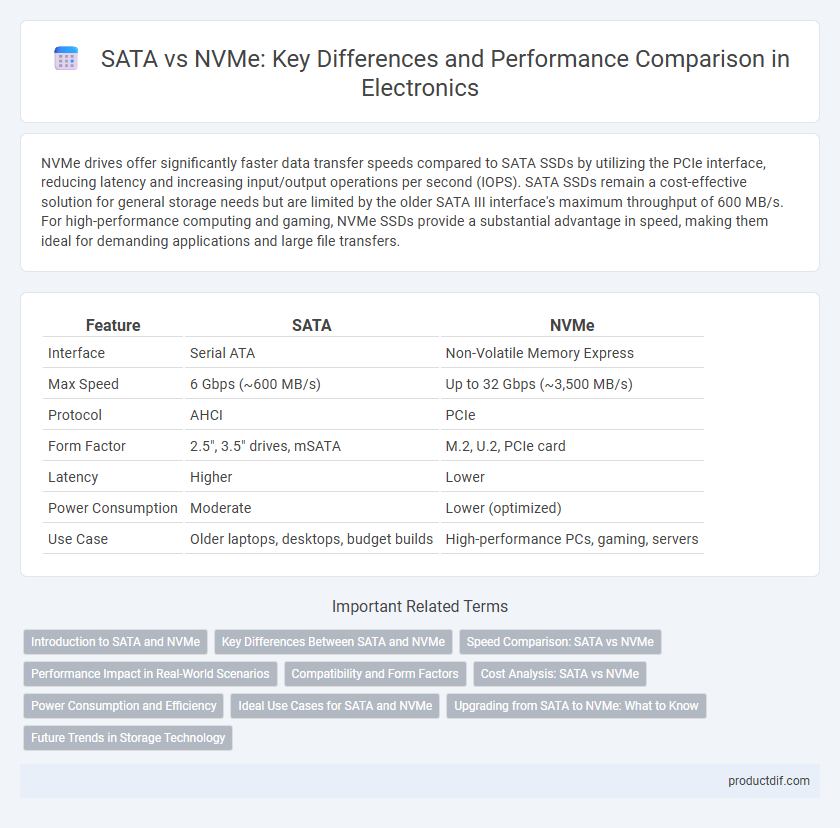NVMe drives offer significantly faster data transfer speeds compared to SATA SSDs by utilizing the PCIe interface, reducing latency and increasing input/output operations per second (IOPS). SATA SSDs remain a cost-effective solution for general storage needs but are limited by the older SATA III interface's maximum throughput of 600 MB/s. For high-performance computing and gaming, NVMe SSDs provide a substantial advantage in speed, making them ideal for demanding applications and large file transfers.
Table of Comparison
| Feature | SATA | NVMe |
|---|---|---|
| Interface | Serial ATA | Non-Volatile Memory Express |
| Max Speed | 6 Gbps (~600 MB/s) | Up to 32 Gbps (~3,500 MB/s) |
| Protocol | AHCI | PCIe |
| Form Factor | 2.5", 3.5" drives, mSATA | M.2, U.2, PCIe card |
| Latency | Higher | Lower |
| Power Consumption | Moderate | Lower (optimized) |
| Use Case | Older laptops, desktops, budget builds | High-performance PCs, gaming, servers |
Introduction to SATA and NVMe
SATA (Serial ATA) is a computer bus interface primarily used for connecting hard drives and SSDs, offering data transfer speeds up to 6 Gbps. NVMe (Non-Volatile Memory Express) is a high-performance protocol designed specifically for SSDs connected via PCIe, enabling significantly faster data transfer rates, often exceeding 32 Gbps. NVMe leverages parallelism and low latency to optimize storage performance compared to the traditional SATA interface.
Key Differences Between SATA and NVMe
SATA drives utilize the AHCI protocol designed for traditional spinning hard drives, resulting in lower data transfer rates typically capped at 600 MB/s, while NVMe drives employ a high-speed PCIe interface enabling speeds exceeding 3,500 MB/s. SATA interfaces use a serial bus with limited queue depth, whereas NVMe supports thousands of parallel command queues for enhanced multitasking and reduced latency. NVMe's architecture is optimized for solid-state storage, delivering superior performance in random read/write operations compared to SATA's legacy design.
Speed Comparison: SATA vs NVMe
NVMe drives deliver significantly higher data transfer speeds compared to SATA, with NVMe reaching up to 3500 MB/s compared to SATA's maximum of around 600 MB/s due to the limitations of the SATA III interface. NVMe leverages the PCIe interface, allowing multiple lanes for parallel data transmission, resulting in substantially lower latency and faster read/write speeds. This speed advantage makes NVMe the preferred choice for high-performance computing tasks, gaming, and professional applications requiring rapid data access.
Performance Impact in Real-World Scenarios
NVMe drives utilize the PCIe interface, offering significantly higher bandwidth and lower latency compared to SATA's AHCI-based connection, resulting in faster data transfer speeds in real-world applications. In tasks such as large file transfers, gaming load times, and database operations, NVMe SSDs demonstrate up to 5x throughput improvement and reduced input/output operations per second (IOPS) latency. SATA SSDs remain suitable for everyday computing but show bottlenecks in high-performance environments where NVMe's parallelism and queue depth capabilities deliver substantial performance gains.
Compatibility and Form Factors
SATA drives use the AHCI protocol and commonly come in 2.5-inch and 3.5-inch form factors, compatible with most desktop and laptop systems via standard SATA connectors. NVMe drives utilize the PCIe interface and are primarily available in M.2 and U.2 form factors, requiring motherboard support for NVMe over PCIe slots and offering faster data transfer speeds. Compatibility depends on the system's motherboard and available connectors, with SATA being universally supported and NVMe needing specific PCIe lanes and BIOS support.
Cost Analysis: SATA vs NVMe
SATA SSDs generally offer lower cost per gigabyte, making them a budget-friendly option for storage upgrades compared to NVMe drives, which command higher prices due to faster PCIe interfaces and superior performance. NVMe SSDs deliver significantly better read/write speeds and lower latency, justifying their premium for applications requiring high throughput and quick data access despite the higher initial investment. Cost efficiency depends on use case; SATA is ideal for everyday computing and large-capacity storage needs, while NVMe suits gaming, content creation, and enterprise environments demanding speed and responsiveness.
Power Consumption and Efficiency
NVMe SSDs typically consume more power than SATA SSDs due to higher data transfer rates and advanced controller technology, but they achieve greater efficiency by completing data tasks faster, reducing overall runtime. SATA SSDs have lower power draw in idle states, making them suitable for energy-sensitive applications, though they lag in throughput compared to NVMe drives. In power-sensitive environments, the choice hinges on balancing immediate power consumption against total energy used over task completion.
Ideal Use Cases for SATA and NVMe
SATA SSDs excel in budget-friendly storage solutions, ideal for everyday computing tasks, moderate data transfers, and older systems requiring reliable upgrade paths. NVMe drives deliver superior performance with high bandwidth and low latency, making them perfect for gaming, video editing, 3D rendering, and data-intensive applications. Choosing NVMe suits professionals and enthusiasts needing maximum read/write speeds, while SATA remains suitable for standard consumer workloads and cost-effective storage expansion.
Upgrading from SATA to NVMe: What to Know
Upgrading from SATA to NVMe significantly boosts data transfer speeds, with NVMe drives reaching up to 3500 MB/s compared to SATA's limit of 600 MB/s. NVMe interfaces leverage PCIe lanes, reducing latency and enhancing I/O performance for demanding applications like gaming and video editing. Compatibility with motherboard M.2 slots or PCIe adapters is essential for a smooth upgrade, ensuring full utilization of NVMe's advanced capabilities.
Future Trends in Storage Technology
NVMe is rapidly becoming the preferred storage interface due to its superior speed and low latency compared to SATA, which is limited by the SATA III bandwidth bottleneck of 6 Gbps. Future trends indicate widespread adoption of NVMe-based SSDs in consumer and enterprise applications, driven by advancements in PCIe 5.0 and 6.0 protocols that promise even higher throughput and efficiency. Emerging storage technologies like persistent memory and computational storage are expected to integrate seamlessly with NVMe, further accelerating data processing and reducing system bottlenecks.
SATA vs NVMe Infographic

 productdif.com
productdif.com